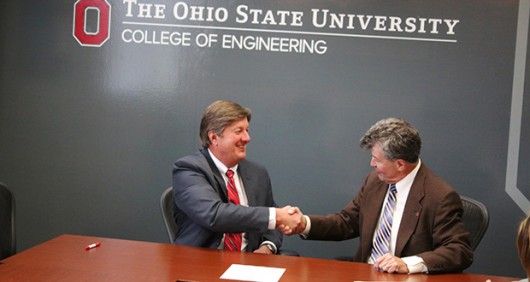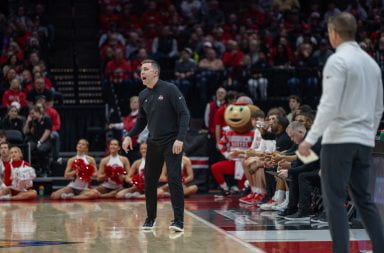
Steve Wathen (left), chairman and co-founder of the Youth Aviation Aventure Program, and David Williams, dean of the College of Engineering, sign the memorandum of understanding between the Youth Aviation Adventure Program and OSU’s Career Eagles Program in Hitchcock Hall on April 7. Credit: Yann Schreiber / Lantern reporter
When Steve Wathen and his friend Dan Kiser, both pilots, started to organize days of immersion in aviation, they didn’t think their Youth Aviation Adventure Program would be offered around the country or get partnered with one of the biggest universities in the U.S.
Wathen, chairman and co-founder of the Youth Aviation Adventure Program, was at Ohio State on Tuesday to sign a memorandum of understanding with the university’s new Career Eagle program. This memorandum is a partnership agreement that will allow the program to expand to reach a broader audience nationwide.
David Williams, dean of the College of Engineering, also signed the memorandum on behalf of OSU during the meeting at Hitchcock Hall.
The Career Eagles Aviation Initiative, a partnership of OSU, the Experimental Aircraft Association and the Austin E. Knowlton Foundation, aims to promote careers in the field of aviation to middle and high schools in Ohio and throughout the country, according to the Career Eagles’ website.
“The mission of Career Eagles is … to promote and support the aviation industry by providing resources and programming that will develop and engage the next generation of pilots,” said Shannon Morrison, Career Eagles program coordinator at the Center for Aviation Studies.
“Career Eagles has become a place where parents and schools can go and get information in aviation careers. We offer our own programming, but we are also becoming a major resource for parents,” Morrison said.
The program tries to raise awareness for careers in aviation, as well as address a nationwide and worldwide shortage of pilots through outreach to children.
Global growth in aviation, especially in Asia and India, has led to an increased demand for pilots, said Seth Young, director of the Center for Aviation Studies at OSU. Additionally, there is a “decrease in the number of pilots,” he said.
This decrease is fueled by a wave of retirements of pilots trained in the 1960s and 1970s, as well as less interest in the field since the 1970s, Young said.
Many young people “don’t see (aviation) as a viable career” because of unstable airlines or reports in the media of relatively low pay, Young said. Additionally, he said the required experience to work as commercial pilot increased from 250 flight hours to 1,500 hours as a result of new Federal Aviation Administration regulations. Fewer young pilots are willing to go that far, he said.
The shortage of pilots has already resulted in canceled flights and higher airfares, Young said.
“Our goal is to contribute to increasing the number and quality of pilots,” he added.
Austin Knowlton, an OSU graduate in architectural engineering in the class of 1931, created the Knowlton Foundation “to support higher education in areas of his interest,” Young said.
Young added that Career Eagles was developed through subsequent discussions between the Knowlton Foundation and OSU.
The foundation was “proud to continue to support Ohio State,” said John Lindberg, a trustee of the Knowlton Foundation who represented the foundation at Tuesday’s signing.
“Aviation was one of Mr. Knowlton’s passions, together with OSU,” he said. The Knowlton Foundation provided the funding for the Career Eagles Aviation Initiative.
The Knowlton Foundation already has a footprint on OSU’s campus, most notably through the Knowlton School of Architecture.
The curriculum of the Youth Aviation Adventure program was developed with the help of OSU’s College of Education before being exported to other airports and cities, Wathen said. It typically consists of a five-hour program, usually held on a Saturday once or twice per year, offered for free.
“Our goal is to reach kids,” Walthen said, adding that everyone in the program is a volunteer.
Through the partnership, the Youth Aviation Adventure hopes to further develop its academic reputation, Wathen said. OSU, on the other hand, hopes to increase the reach of its Career Eagles program though the existing programs by Youth Aviation Adventure in about 30 states and, ultimately, increase awareness for the aviation program at OSU, he added.
Through the memorandum of understanding, Career Eagles and Youth Aviation Adventure will “be able to share resources,” such as curriculums or information on student participation, Morrison said. Career Eagles also offers scholarships, Morrison said.
Without this kind of pipeline, “all education and research is useless,” Williams said.
The program “is not necessarily only trying to recruit students to attend Ohio State. It has a much larger purpose of tying to get students in aviation generally,” Morrison said.
Still, Morrison added, “it does help get the word out there that Ohio State does have an aviation program and, hey, look, they do this interesting, innovative thing for the industry.”
OSU “couldn’t stand alone to supply the nation’s pilots,” Young said. “(It is) more important to get (children) interested.”


